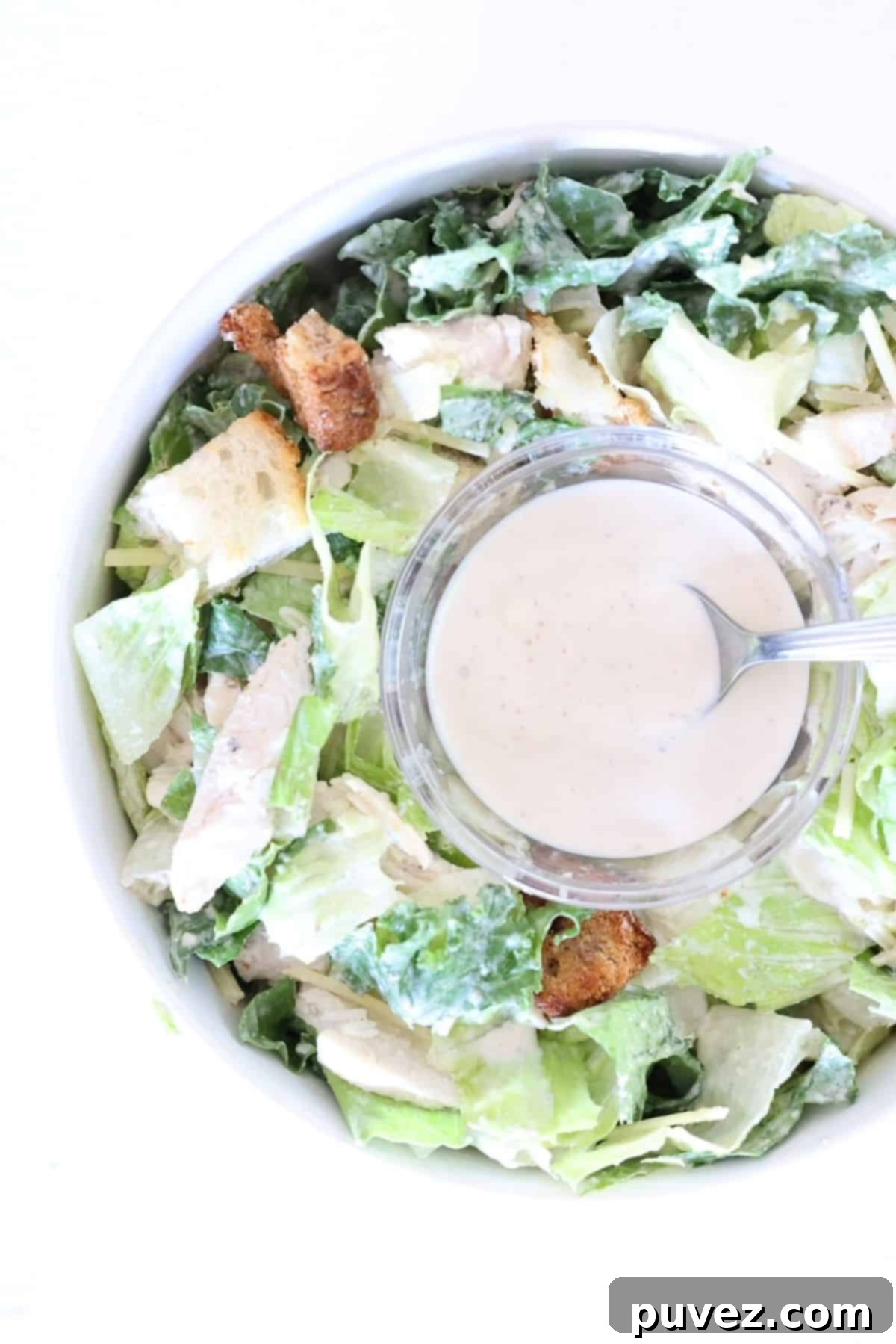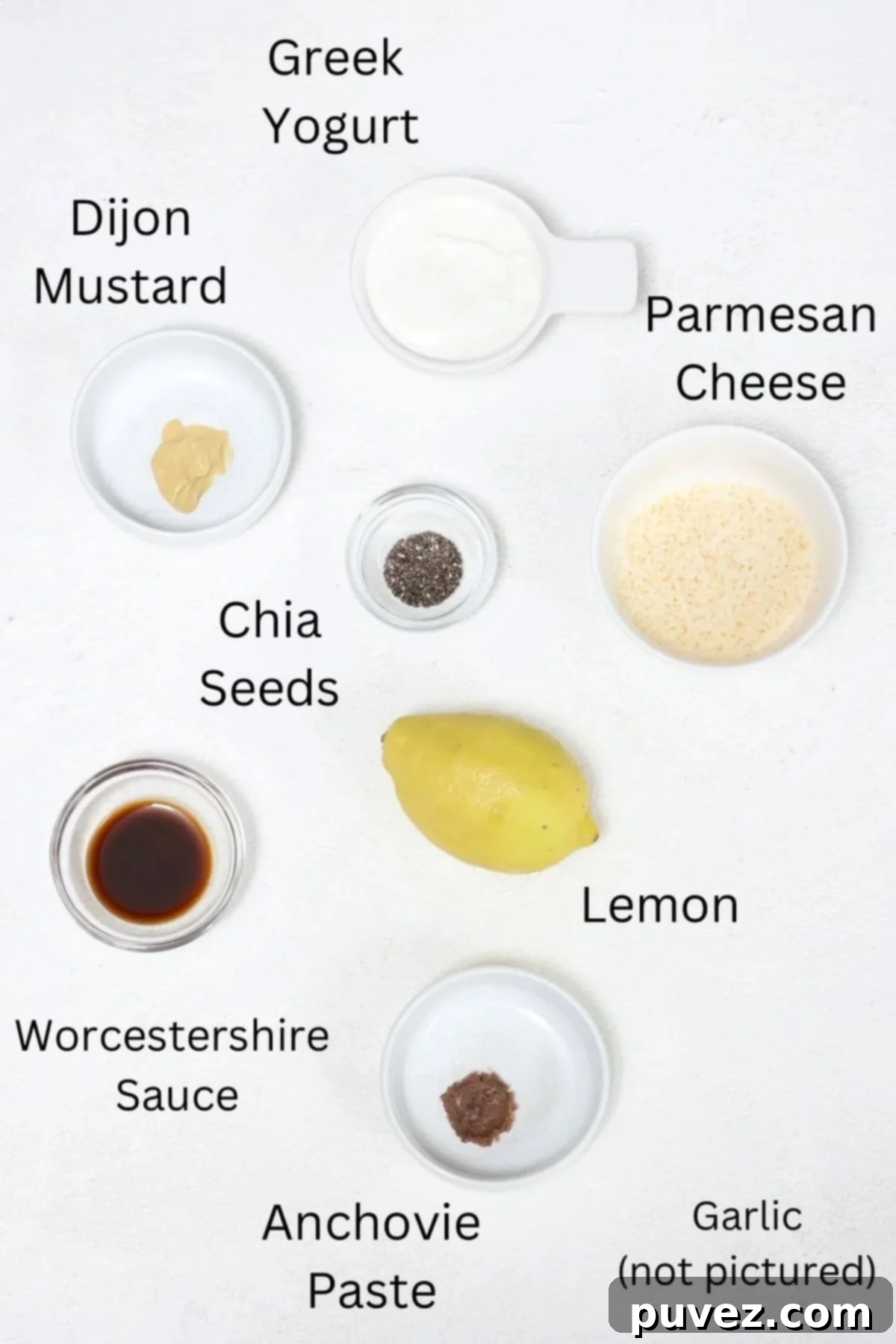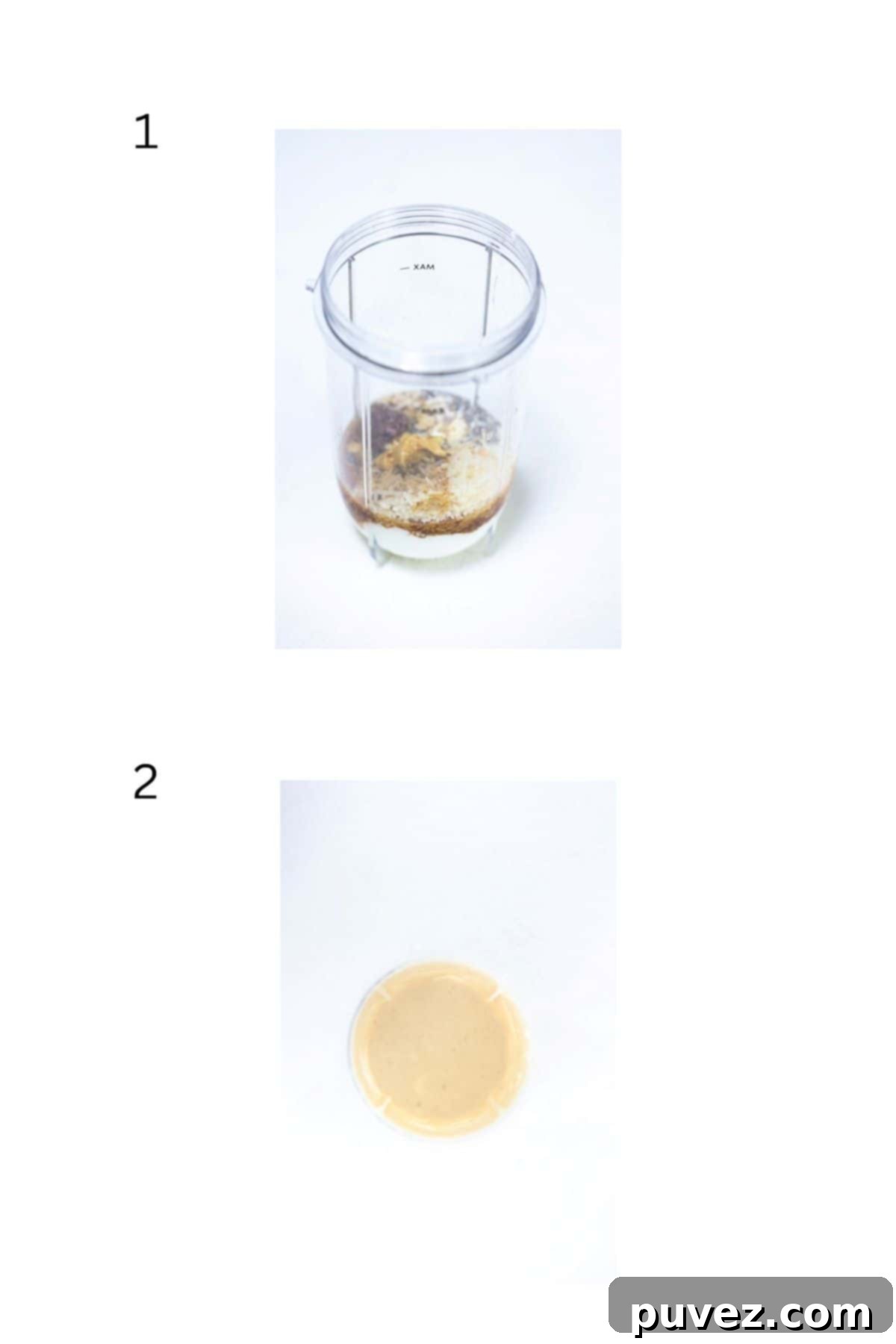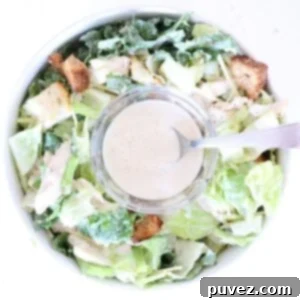Creamy & Healthy Caesar Salad Dressing (No Mayo) | A Dietitian’s Recipe
Are you searching for a delicious, creamy Caesar salad dressing that’s also a healthier alternative to traditional recipes? Look no further! This easy-to-make Caesar Salad Dressing (no mayo), crafted by a registered dietitian, is your answer to enjoying classic Caesar salad more often. Prepare for your family, especially the kids, to adore it and quite possibly lick their plates clean – it’s truly that good!

The idea of making homemade Caesar salad dressing might seem daunting, but it’s much simpler than you imagine. While many classic Caesar dressing recipes rely on raw egg yolks for their signature creaminess, this innovative version achieves the same luscious texture using Greek yogurt instead. This simple swap not only makes the dressing safer by eliminating raw eggs but also boosts its nutritional profile significantly.
As a dietitian and a mom, I’m always looking for ways to make family meals both nutritious and appealing. When I can whip up a homemade salad dressing that tastes as good as, or even better than, store-bought options – and that my kids genuinely enjoy – it’s a win-win! Especially when all it takes is a quick blend of ingredients in a food processor or blender before serving. It’s incredibly easy, making healthy eating accessible even on the busiest weeknights.
So, on your next trip to the grocery store, be sure to pick up some fresh, crisp romaine lettuce. Pair it with your favorite protein, like grilled or shredded chicken breast, and don’t forget the crunch of store-bought or homemade croutons. Toss everything together with a generous amount of this creamy, flavorful dressing for a truly satisfying and effortlessly healthy weeknight meal that will have everyone asking for seconds.
Why You’ll Fall in Love with This Healthy Homemade Caesar Dressing
This isn’t just another salad dressing recipe; it’s a game-changer for anyone who loves Caesar salad but wants a healthier, homemade option. Here’s why this particular recipe will become a staple in your kitchen:
- Effortless Preparation: Forget complicated steps or lengthy cooking times. This recipe requires absolutely no cooking. Simply measure your ingredients, add them to a blender, and blend until smooth. It’s perfect for busy individuals and families who want delicious results without the fuss. The entire process takes just minutes, making it ideal for impromptu weeknight dinners.
- Kid-Approved Flavor: As a parent, finding healthy recipes that kids genuinely love can be a challenge. My eldest daughter, a true Caesar salad enthusiast, gives this recipe her enthusiastic seal of approval! This dressing captures all the beloved, familiar flavors of a classic Caesar – the savory depth of anchovies, the rich tang of Parmesan cheese, and the aromatic kick of garlic – ensuring even the pickiest eaters will ask for more. It’s a fantastic way to get more greens onto their plates.
- Authentic Homemade Taste: There’s nothing quite like a dressing made from scratch with simple, wholesome ingredients. This recipe brings you that authentic, fresh taste that store-bought dressings often lack. You’ll use common pantry staples, with canned anchovies or anchovy paste readily available next to canned tuna in most grocery stores. The fresh ingredients truly make a difference in flavor intensity and quality.
- No Raw Eggs – Safer & Allergy-Friendly: Traditional Caesar dressings often contain raw egg yolks, which can pose a risk of foodborne illness and make the dressing unsuitable for those with egg allergies. This recipe ingeniously replaces raw egg yolks and mayonnaise with a combination of creamy Greek yogurt and chia seeds. This clever swap not only eliminates health concerns but also:
- Reduces the amount of saturated fat, contributing to a heart-healthier profile.
- Significantly increases the protein content, making your salad more satisfying.
- Minimizes the risk of foodborne illnesses, offering peace of mind.
- Opens up the world of delicious Caesar salad to kids and adults with egg allergies.
- A Truly ‘Healthy’ Caesar Salad Dressing: While the term “healthy” is subjective, this dressing earns its description by enhancing nutritional value without sacrificing taste. Greek yogurt contributes a significant amount of protein and calcium, both essential for strong bones and overall well-being. Furthermore, the inclusion of anchovies and chia seeds delivers a powerful dose of healthy Omega-3 fatty acids. These beneficial fats are often missing from commercial dressings and are crucial for brain health, reducing inflammation, and supporting cardiovascular function. This dressing offers more than just great taste; it provides a nutritional boost with every serving.
Essential Ingredient Notes for Your Perfect Dressing
The magic of this homemade Caesar dressing lies in its carefully selected, simple ingredients. Understanding each component will help you achieve the best flavor and texture every time. Here’s a breakdown of what you’ll need and why:

- Greek Yogurt: This is the star ingredient that replaces mayonnaise and raw eggs, providing an incredible boost of protein, calcium, and vitamin D. I specifically use plain 2% Greek yogurt for a balance of creaminess and lower saturated fat content. It contributes to the dressing’s rich, thick texture while adding a slight tang that complements the other savory elements beautifully. Opting for full-fat Greek yogurt would result in an even richer dressing, while fat-free would be lighter.
- Fresh Lemon Juice: Essential for balancing the rich, savory flavors, fresh lemon juice adds a bright, zesty note and a crucial acidic element. It also provides a dose of vitamin C, enhancing the overall nutritional value. Always use fresh lemon juice for the best flavor; bottled varieties simply don’t compare.
- Worcestershire Sauce: This ingredient is vital for achieving that classic, deep umami flavor expected from a Caesar dressing. There isn’t an exact substitute that will provide the same complex savory notes, so try not to skip it. For dietary restrictions, ensure you check labels for gluten-free or vegan varieties if needed.
- Parmesan Cheese: Contributes a salty, nutty depth and helps achieve the desirable texture. I recommend using freshly shredded or pre-shredded Parmigiano Reggiano (like the one from Costco) for optimal results. Avoid finely grated, powder-like cheese (often used for topping spaghetti) as it can lead to a gritty texture in the blended dressing, which most people find less appealing.
- Anchovies (or Anchovy Paste): Don’t let these tiny fish intimidate you! Anchovies are the secret weapon for Caesar dressing, imparting its distinctive salty, savory, and umami flavor that we all crave. They melt into the dressing, leaving no fishy taste, only incredible depth. Beyond flavor, anchovies are a nutritional powerhouse, packed with vitamin D, iron, and crucial Omega-3 fatty acids. You can use either whole anchovy fillets from a can or convenient anchovy paste from a tube.
- Dijon Mustard: Added for its pungent, slightly spicy flavor and its natural emulsifying properties, which help create a smooth, unified dressing. Dijon is a cornerstone of many classic vinaigrettes and dressings. While mustard powder can be a substitute, I do not recommend using milder mustards like Grey Poupon, as they won’t provide the same depth of flavor.
- Fresh Garlic: Fresh garlic cloves are highly recommended for their robust, aromatic flavor. If fresh isn’t available, garlic powder can be used as a substitute, though the taste won’t be quite as vibrant. If you have a garlic sensitivity, you can omit it, but be aware that it will alter the dressing’s traditional taste profile (in my opinion, it’s a key ingredient!).
- Chia Seeds: A brilliant addition for thickening the dressing naturally without adding unhealthy fats or raw eggs. Chia seeds absorb liquid and expand, contributing to a rich, creamy consistency. They are also an excellent source of Omega-3 fatty acids and fiber, further boosting the health benefits of this dressing.
- Salt & Black Pepper: Essential seasonings to enhance and round out all the flavors. Always add salt and freshly ground black pepper to taste, adjusting as needed to suit your preference.
How to Prepare This Creamy No-Mayo Caesar Dressing
You’ll be amazed at how quickly and effortlessly this delicious and healthy dressing comes together. The preparation is incredibly straightforward, requiring minimal effort for maximum flavor.

For a detailed list of ingredients with precise measurements and specific instructions, please refer to the comprehensive recipe card below. However, here’s a quick overview of the two simple steps:
- Combine All Ingredients: Gather all of your measured ingredients and add them into either a small blender or a bowl if you plan to use an immersion blender. Ensure everything is in one place, ready for blending.
- Blend to Creamy Perfection: Secure the lid on your blender (or submerge your immersion blender) and process until the mixture transforms into a wonderfully smooth and creamy texture. There should be no visible chunks of garlic, anchovies, or chia seeds. That’s all there is to it! Your fresh, homemade Caesar dressing is now ready to elevate any salad.
Helpful Tips for the Best No-Mayo Caesar Dressing
To ensure your homemade Caesar dressing turns out perfectly creamy and flavorful every time, keep these tips in mind:
- Choose the Right Blender: For the absolute best texture, I highly recommend using a small immersion blender or a powerful personal-sized blender. These devices are excellent at creating an ultra-smooth, emulsified consistency, ensuring no gritty bits remain and all flavors are perfectly integrated. While a larger blender will work, smaller models often provide a finer blend for dressings.
- Adjusting Thickness: If you prefer a thicker salad dressing, simply add a small amount of additional chia seeds (about ¼ to ½ teaspoon at a time) and blend again. Allow the dressing to sit for a few minutes after blending, as chia seeds will continue to absorb liquid and thicken over time. If it becomes too thick, a splash of water or extra lemon juice can help thin it out.
- Anchovy Versatility: You can use either one whole anchovy fillet (packed in oil) or one-half teaspoon of anchovy paste for this recipe. Both provide the essential umami flavor. If you’re new to cooking with anchovies, starting with the paste can be simpler for measuring.
- Anchovies: Fillets vs. Paste: Canned anchovy fillets are often more readily available and can be less expensive per serving than anchovy paste. However, if you don’t use whole anchovies frequently, the remainder of the can might go to waste. For convenience and to avoid waste, I often find anchovy paste to be more economical in the long run, as it comes in a resealable tube and lasts longer in the fridge.
- Making Your Own Anchovy Paste: If anchovy paste isn’t available, or you simply prefer using fillets, you can easily create your own paste. Just mash one or two anchovy fillets with the back of a spoon until a smooth, paste-like consistency is achieved. While the blending process will break down the fillets anyway, pre-mashing ensures more precise measurement and guarantees an even distribution of flavor, especially if your blender isn’t super powerful.
- Parmesan Cheese Texture: For the smoothest dressing, use shredded Parmesan cheese. If your kids (or you) don’t mind a slightly gritty consistency, you *could* substitute finely grated parmesan cheese (the kind typically found in a shaker for topping spaghetti). Personally, I find the texture less desirable with finely grated cheese, but some people don’t mind it. Always go with what your family prefers!
Dietitian’s Insight: Boosting Nutrition in Your Dressings
As a dietitian, I often emphasize that small, strategic ingredient swaps can significantly impact your overall nutrient intake. Blended recipes, like this Caesar dressing, offer an excellent opportunity to easily increase your fiber and protein intake without compromising on taste or convenience.
Consider the thoughtful substitutions in this recipe: by choosing Greek yogurt over traditional mayonnaise and incorporating chia seeds, you’re adding almost 3 grams of protein and a full gram of fiber per 2-tablespoon serving. While these numbers might seem small individually, these incremental nutritional boosts accumulate quickly, contributing to a more balanced diet, improved satiety, and better digestive health. Every little bit truly adds up to a healthier you!
Frequently Asked Questions About This No-Mayo Caesar Dressing
Here are some common questions you might have about making and enjoying this healthy Caesar dressing:
The primary difference between canned anchovies and anchovy paste lies in their form and packaging, though their core ingredients (anchovies, oil, and salt) are essentially the same. Canned anchovy fillets are whole fish preserved in oil, typically found in small tins. Anchovy paste, on the other hand, is a finely ground purée of anchovies, usually mixed with olive oil and salt, packaged in a convenient tube. Both offer the same deep, umami flavor, but the paste is often easier to measure and blend seamlessly into dressings.
To maintain freshness and flavor, always store this homemade Caesar dressing refrigerated in an airtight container. A glass mason jar works wonderfully, allowing you to easily spoon out the creamy dressing as needed. When stored properly, this dressing will typically last for up to 5-7 days in the refrigerator. Always give it a good stir or shake before each use, as some separation can occur.
Absolutely! While this recipe uses Greek yogurt for a creamy, no-mayo, no-egg base, there are indeed other delicious variations. The first and most common type of homemade Caesar dressing, like this one, has a creamy consistency. Our recipe achieves this with Greek yogurt, but some might use other dairy-free alternatives or even soaked cashews for a vegan version. The second type of Caesar dressing I’m familiar with is more akin to a vinaigrette. This style typically foregoes any creamy base and is made using high-quality extra virgin olive oil, lemon juice, garlic, and anchovy, resulting in a lighter, more zesty dressing.
A single tablespoon of this dressing contains approximately 70mg of sodium. It’s important to note that the exact sodium content can fluctuate based on several factors, including the specific type of Parmesan cheese you use (some are saltier than others), whether you opt for regular or lower-sodium Worcestershire sauce, and, of course, the amount of additional salt you add “to taste.” If you or a family member are following a sodium-restricted diet, it’s advisable to use this dressing sparingly or explore lower-sodium alternatives, such as my refreshing Healthy Strawberry Vinaigrette.
Yes, this dressing is excellent for meal prepping! You can prepare a batch at the beginning of the week and store it in an airtight container in the refrigerator for up to 5-7 days. In fact, the flavors often meld and deepen over a day or two, making it even more delicious. Just give it a good shake or stir before serving.
More Delicious & Easy Salad Dressings You’ll Love
If you enjoyed this healthy Caesar dressing, be sure to explore some of my other favorite homemade dressing recipes to add variety to your meals:
- Easy Mango Dressing
- Basil Balsamic Dressing
- Lemon Garlic Salad Dressing
- Easy Apple Cider Vinaigrette Recipe
Pair Your Salad with These Simple & Healthy Side Dishes
Looking for more easy and nutritious side dishes to complement your Caesar salad? Here are some fantastic recipes that are simple to prepare and packed with flavor:
- Homemade Unsweetened Applesauce
- Easy Kale (Tuscan) Salad
- Easy Strawberry Balsamic Salad Dressing
- Quick and Easy Air Fryer Roasted Sweet Potatoes
Did your kids love this homemade salad dressing? Please take a moment to leave a 5-star rating below or share your thoughts in the comments section! Your feedback helps other families discover this fantastic recipe.
Don’t forget to snap a pic of your delicious salad creation and tag @carrots.and.cookies on Instagram so I can see it. Enjoy the healthy and flavorful journey!
📖 Recipe

Caesar Salad Dressing (No Mayo)
Kristi
Pin Recipe
Equipment
-
Immersion blender (or small regular blender).
-
Measuring cups and spoons
Ingredients
- ½ cup Greek yogurt Low Fat, plain Greek yogurt for best texture and protein.
- 2 teaspoons lemon juice Always use fresh lemon juice for vibrant flavor.
- ½ teaspoon chia seeds For thickening and Omega-3s.
- 2 teaspoons Worcestershire sauce Crucial for authentic Caesar flavor.
- 1 garlic clove Minced; use fresh for best taste.
- ¼ cup parmesan cheese Shredded, not finely grated, for smooth consistency.
- 1 teaspoon Dijon mustard Adds tang and helps emulsify.
- ½ teaspoon anchovy paste For umami flavor (see notes for alternative).
- 1 Pinch salt Adjust to taste.
- 1 Pinch black pepper One to two pinches of freshly ground black pepper for best flavor.
Instructions
-
Add all ingredients to a small blender or bowl (if using an immersion blender). Ensure all ingredients are scraped into the bottom for thorough blending.½ cup Greek yogurt, 2 teaspoons lemon juice, ½ teaspoon chia seeds, 2 teaspoons Worcestershire sauce, 1 garlic clove, ¼ cup parmesan cheese, 1 teaspoon Dijon mustard, ½ teaspoon anchovy paste, 1 Pinch salt, 1 Pinch black pepper
-
Blend until a smooth and creamy consistency is reached. You may need to scrape down the sides occasionally. Serve immediately or refrigerate for flavors to meld further. Enjoy!
Notes
- I highly recommend using an immersion blender or a small, powerful personal blender to make this dressing. It truly helps achieve the smoothest, most homogenous and creamy consistency.
- If you prefer an even thicker dressing, you can add an additional ¼ to ½ teaspoon of chia seeds and blend again. Allow it to sit for a few minutes for maximum thickening.
- For a truly smooth texture, use shredded Parmesan cheese instead of the finely grated, powder-like variety (often sold in a shaker for spaghetti). Finely grated cheese can result in a slightly gritty texture in the blended dressing, which some people may find less appealing.
- If using whole anchovy fillets from a can instead of anchovy paste, begin by adding one fillet. Blend the dressing, then taste it. If you desire a stronger, more pronounced anchovy flavor, you can add another half or whole anchovy fillet and blend again until smooth.
- This dressing can be made ahead of time and stored in an airtight container in the refrigerator for up to 5-7 days. The flavors often deepen and improve over time.
Nutrition
Tried this recipe?Let us know how it was!
